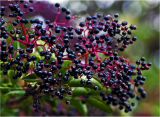
Background
“Black elder or elderberry (Sambucus nigra L.) is a deciduous, tree-like shrub, widespread in almost every continent of the world. It usually blooms from May to July and the berries ripen from August to late September,” (1). The purplish-black berries have been used for centuries for medicinal purposes, attributed to its many phytochemicals (1). Elderberry is also rich in carbohydrates, proteins, fats, fatty acids, organic acids, minerals, vitamins and essential oils (2).
Elderberries contain water-soluble plant pigments, known as anthocyanins, which are found in a variety of dark-colored fruits and vegetables (3), such as red cabbage microgreen, blueberry, blackcurrant, mulberry, cherry, black elderberry, and chokeberry (4). Anthocyanins are known to have antioxidative and anti-inflammatory properties which play a role in the prevention and treatment of many chronic diseases (4).
How much and for how long?
A systematic review and meta-analysis of randomized controlled trials suggest that differences in dose and duration of anthocyanin supplementation matter! For example, in one study, 12 weeks of supplementation significantly reduced weight, BMI, HDL, and LDL. However, a different study with less than 12 weeks of supplementation resulted in higher systolic and diastolic blood pressure.
In terms of dose, one randomized controlled trial found a significant reducing effect of > 300 mg of anthocyanin supplementation on triglycerides and LDL, especially in patients with hypercholesterolemia (3).
Diabetes & Insulin Resistance
Diabetes mellitus is a disorder characterized with persistent high blood sugar. Type 1 diabetes results from a deficiency in insulin secretion and type 2 diabetes results from a resistance to insulin. If not adequately managed, blood sugar can rise and lead to significant damage to vital organs (5).
After systematically reviewing the literature, authors concluded that supplementation with anthocyanin can have beneficial effects on insulin resistance in adults. “HbA1c as a marker for long-term glycemic control, has shown an improvement in response to anthocyanin supplementation. It is expected that weight reduction and controlling obesity are achieved by increasing insulin sensitivity with anthocyanin,” (3). In addition to its effects on insulin resistance, anthocyanin supplementation has been shown to reduce body weight, leading to a restored glucose tolerance (4).
Obesity & Inflammation
What does obesity and insulin resistance have in common? Inflammation.
Chronic inflammation plays a critical role in the development of obesity due to its association with diseases such as type 2 diabetes, cardiovascular diseases, pulmonary diseases and cancer. With that being said, targeting inflammation can be a potential strategy in helping to resolve health problems related to obesity (4).
Supplementation of anthocyanin mixtures have been found to be more influential than anthocyanins alone. For example, combinations of blackberries and raspberries have a synergistic antioxidant capacity which can reduce inflammatory markers in hypercholesterolemic patients (4).
Aside from inflammation, oxidative stress has also been a recurring theme in both obesity and insulin resistance. The role of oxidative stress “under the state of obesity is upregulated while antioxidant defenses diminish over time and this trend is even greater after the onset of diabetes,” (5).
Metabolism & Oxidative Stress
Reactive oxygen species are involved in many physiological processes but too much, or too little, can be harmful to your body (6). An abnormal concentration of reactive oxygen species is referred to as oxidative stress.
A 2016 publication in Food Chemistry found that elderberry extract has the ability to “protect the human colon against the effects of oxidative stress, such as enhanced intracellular reactive oxygen species production, oxidative DNA damage, and mutagenicity,” (6).
Why does elderberry extract have the ability to protect the human colon? It has the ability to prevent overproduction of reactive oxygen species in the intestines, which can cause oxidative stress and act as a trigger for carcinogenesis (6).
References
(1) Senica M, Stampar F, Veberic R, Mikulic-Petkovsek M. Processed elderberry (Sambucus nigra L.) products: A beneficial or harmful food alternative? LWT – Food Science and Technology. 2016; 72: 182-188.
(2) Młynarczyk K, Walkowiak-Tomczaka D, Łysiakb, GP. Bioactive properties of Sambucus nigra L. as a functional ingredient for food and pharmaceutical industry. Journal of Functional Foods. 2018; 40: 377-390.
(3) Daneshzad E, Shab-Bidar S, Mohammadpour Z, Djafarian K. Effect of anthocyanin supplementation on cardio-metabolic biomarkers: A systematic review and meta-analysis of randomized controlled trials. Clinical Nutrition. 2018; xxx: 1-13.
(4) Yoon-Mi L, Young Y, Yoon H, Hyun-Min P, Song S, Kyung-Jin Yeum. Dietary anthocyanins against obesity and inflammation. Nutrients. 2017; 9(10):1089.
(5) Belwal T, Nabavi SF, Nabavi SM, Habtemariam S. Dietary Anthocyanins and Insulin Resistance: When Food Becomes a Medicine. Nutrients. 2017; 9(10): 1111.
(6) Olejnik A, Olkowicz M, Kowalska K, Rychlik J, Dembczyński R, Myszka K, Juzwa W, Białas W, Moyer, MP. Gastrointestinal digested Sambucus nigra L. fruit extract protects in vitro cultured human colon cells against oxidative stress. Food Chemistry. 2016; 197(A): 648-657.
Written by Nicole Lindel, MS in Nutrition Education from Columbia University
